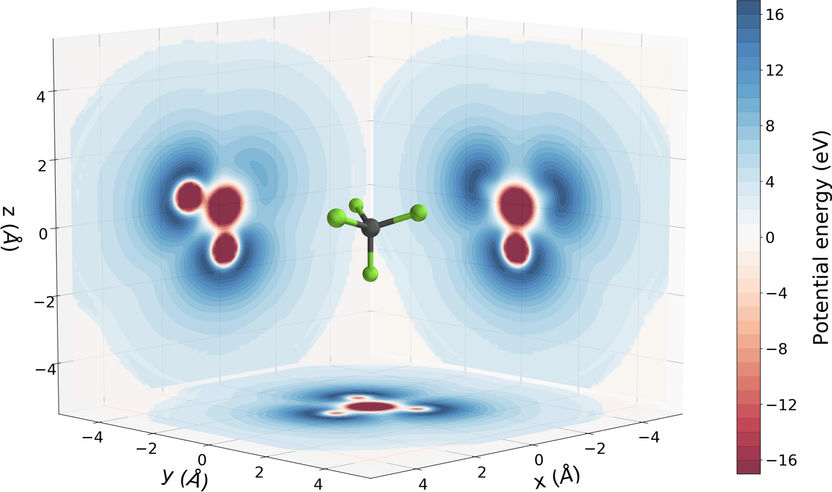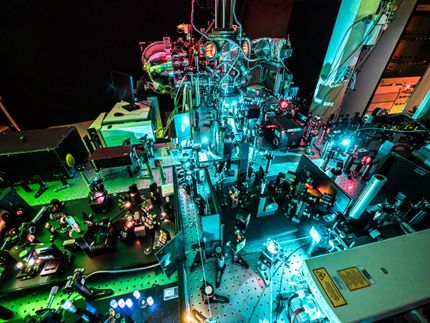Complex pathways influence time delay in ionization of molecules
Study shows how the mechanism of photoionization can be used to gain insights into complex molecular potentials
How can researchers use the mechanism of photoionization to gain insight into complex molecular potential? This question has now been answered by a team led by Prof. Dr. Giuseppe Sansone from the Institute of Physics at the University of Freiburg. The researchers from Freiburg, the Max Planck Institute for Nuclear Physics in Heidelberg and groups at the Universidad Autonoma in Madrid/Spain and the University of Trieste/Italy have published their results in the journal Nature Communications.

Potential landscape of a CF4 molecule, in which a central carbon atom (gray) is surrounded by four fluorine atoms (green) positioned at the vertices of a tetrahedron. The three projections are cuts of the molecular potential, with the blue and red regions indicating points of positive and negative potential energy, respectively.
AG Sansone
In the origin of photoionization, also called the photoelectric effect, an atom or molecule absorbs one quantum of light, usually indicated as photon, from an external field. The energy absorbed in this process is transferred to an electron, which is freed, leaving behind a singly charged ion. In several aspects and for several applications, the effect can be regarded as instantaneous, meaning that there is no significant time delay between the absorption of the photon and the instant when the electron is emitted. However, several experiments conducted in the last years have evidenced that tiny, but measurable delays lying in the attosecond range (1 as=10-18 s) occur between these two processes.
Generation of attosecond pulses
"Thanks to the advanced laser sources and specially designed spectrometers available in our laboratory, we can generate the shortest bursts of light, lasting only few hundreds of attoseconds," Sansone explains. "Moreover, we can reconstruct the orientation of simple molecules when they absorb a photon from an external laser pulse. We have used such pulses to investigate the motion of the electrons after the absorption of a photon."
Electrons experience paths with potential peaks and valleys
The researchers found that on its way out from the molecule, the electron experiences a complex landscape characterized by potential peaks and valleys. These are determined by the spatial distribution of the atoms composing the system. The path followed by the electron during its motion can affect the time it takes to be freed.
Extension to more complex molecular systems possible
In the experiment, the team measured the time delays accumulated by the electrons emitted from CF4 molecules in different spatial directions were measured using an attosecond pulse train combined with an ultrashort infrared field. "Combining this information with the characterization of the spatial orientation of the molecule, we can understand how the potential landscape and, in particular, potential peaks affect the time delay”," says the Freiburg physicist.
The work can be extended to more complex molecular systems and to potentials changing on ultrashort timescales. In general, Sansone emphasizes, this approach could give the possibility to map complex potential landscapes from within, with unprecedented temporal resolution.
Original publication
Ahmadi, H., Plésiat, E., Moioli, M., Frassetto,F., Poletto, L., Decleva, P., Schröter, C. D., Pfeifer, T., Moshammer, R., Palacios, A., Martin, F., Sansone, G.; "Attosecond photoionisation time delays reveal the anisotropy of the molecular potential in the recoil frame"; Nature Communications; 2022, Vol. 13, 1242.
Original publication
Ahmadi, H., Plésiat, E., Moioli, M., Frassetto,F., Poletto, L., Decleva, P., Schröter, C. D., Pfeifer, T., Moshammer, R., Palacios, A., Martin, F., Sansone, G.; "Attosecond photoionisation time delays reveal the anisotropy of the molecular potential in the recoil frame"; Nature Communications; 2022, Vol. 13, 1242.
Topics
Organizations
Other news from the department science

Get the chemical industry in your inbox
By submitting this form you agree that LUMITOS AG will send you the newsletter(s) selected above by email. Your data will not be passed on to third parties. Your data will be stored and processed in accordance with our data protection regulations. LUMITOS may contact you by email for the purpose of advertising or market and opinion surveys. You can revoke your consent at any time without giving reasons to LUMITOS AG, Ernst-Augustin-Str. 2, 12489 Berlin, Germany or by e-mail at revoke@lumitos.com with effect for the future. In addition, each email contains a link to unsubscribe from the corresponding newsletter.
Most read news
More news from our other portals
Last viewed contents
Pall and Zeta Sign Agreement for Automated Process Solutions in Fermenters and Downstream Processing
List_of_UN_Numbers_2901_to_3000
List_of_UN_Numbers_0301_to_0400
X(3872)
Rite_Aid
Mixite
Polypropylene




























































